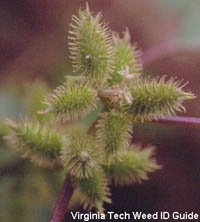Have you ever looked at a tree and wondered how it started growing where it did? Plants have amazing ways of moving their seeds from one place to another to ensure their survival and to produce diverse ecosystems. Let's look at some of the ways plants arrive at their destinations.
 • Hitch-hikers stick to fur, feathers, clothing, or inside animals
• Hitch-hikers stick to fur, feathers, clothing, or inside animals
• Droppers fall to the ground and animals carry them away
• Poppers burst from seed pods and disperse from the plant
• Flyers are carried through the air by wind
• Floaters are carried away in water
• Gardeners purposely plant seeds
Hitch-hikers: Seeds, such as those in prickly cockleburs, can attach to clothing when you take a walk through a field. Seeds can also latch onto the fur of a dog, cat or wild animal as well as the feathers of birds. The seeds will usually fall off or are pulled off the animal in another location. Sometimes seeds stick to the bottom of shoes or in tire grooves and can also end up in a new spot. When birds, bears, raccoons and other animals eat fruit, the seeds move through their digestive systems and are spread in their droppings which help to fertilize the new plant.
 Droppers: Squirrels are famous for carrying away acorns and other nuts that have fallen from trees and burying them for winter food. Sometimes they forget where they've stored the nuts or they don't need everything they've buried. If those nuts last through the winter, they might become large trees.
Droppers: Squirrels are famous for carrying away acorns and other nuts that have fallen from trees and burying them for winter food. Sometimes they forget where they've stored the nuts or they don't need everything they've buried. If those nuts last through the winter, they might become large trees.
Poppers: Some plants have exploding seed pods that burst open and quickly fling seeds away from the parent plant. Dwarf mistletoe can shoot seeds about 20 feet at almost 60 miles per hour. The touch-me-not got its name because of this seed attribute. The plump green pod of Impatiens burst open when touched or become mature.
Flyers: Seeds soar through the air with the wind until they land in a new location. Pine trees produce flat blade-like seeds on high branches that fall off, spin and swirl like blades on a helicopter. Dandelions have seeds encased within lightweight fibers that can act like parachutes and can carry the seed for miles on a strong gust of wind. Poppies have tiny seeds that when open, can shake out and be blown away.
blade-like seeds on high branches that fall off, spin and swirl like blades on a helicopter. Dandelions have seeds encased within lightweight fibers that can act like parachutes and can carry the seed for miles on a strong gust of wind. Poppies have tiny seeds that when open, can shake out and be blown away.
Floaters: Seeds are transported by the water of ditches, puddles, streams, ponds, lakes, rivers and oceans. Heavy rains wash seeds into ditches where they float until the water dries up. Elm seeds can travel for miles after falling into a stream. Coconuts can float in the sea until washed up on shore. Water lilies seeds float in cases of jelly until they sink to the bottom and grow. Fish can eat seeds and deposit them far from the original plant.
Gardeners: Seeds are purposely collected and planted by gardeners, farmers, and landscapers for many reasons including food, flowers, habitat, shade, and natural beauty.
Just think, the next time you see a squirrel burying an acorn, a pine seed blowing in the wind, a bird eating a berry, or you take a walk through a meadow, a new tree may have just been planted.
By Robin Woodroof.
